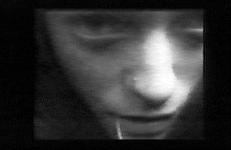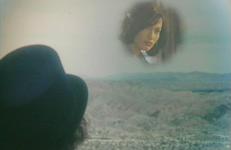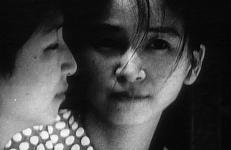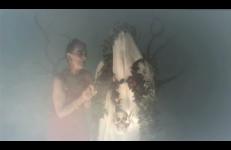In this video, Brenda and Glennda attend and interview participants at the 1991 New York City Pride March. Speaking with a range of attendees, they underscore the significance of non-white queer communities, diverse gender and sexual identities, and political causes at pride events.
LGBTQ
At the Lesbian Museum, Brenda and Glennda interview artists at the opening of Christine Martin’s controversial exhibition The Lesbian Museum: 10,000 Years of Penis Envy at Franklin Furnace. For the exhibition, each artist (including Brenda and Glennda) were given a dildo and asked to turn it into a work of art. The phallus, Freudian philosophy, and female criminality are discussed as a way of analyzing lesbian identity.
In 1995 when TJ Cuthand was 16 they felt like the only lesbian at their Saskatoon high school. This turned out to be untrue, but the lack of visibility in their high school coupled with the lack of representation of Queer teenagers in the 90's made their video, a comedic short about teenage lesbian loneliness and trying to bribe classmates to come out with the promise of candy.
A haunting look at the hidden issues of erotic power relationships between women, told through the reconstructed story of two girlhood friends. In Zando’s tape, the origins of desire and domination are traced to the early stages of the childhood relation between mother and daughter, as revealed in the often fearful and cruel framework of childhood play. In the paradigm of need and dependency versus power and control, the submissive impulse is linked to the transcendent yearning to reunite with the pre-natal mother.
Listen To This is a fragment of collective memory that finds critical relevance in contemporary Queer discourse. Tom Rubnitz weaves narration, image, and a form of temporality, dislocated from ‘real time’, into a video where artist and AIDS activist David Wojnarowicz’s loss and anger is palpable.
When she was 16, Benning stopped going to high school for three weeks and stayed inside with her camera, her TV set, and a pile of dirty laundry. This tape mirrors her psyche during this time. With the image breaking up between edits, the rough quality of this early tape captures Benning’s sense of isolation and sadness, her retreat from the world. As such, Living Inside is the confession of a chronic outsider.
This title is also available on Sadie Benning Videoworks: Volume 1.
Martí arrives in Bilbao for an artistic residency. His clothes take up only a small part of the huge wardrobe in his new room. When he meets someone, the wardrobe gradually begins to fill up. But where did the emptiness go, the free space, the little corner of his own? Did the wardrobe swallow it all, or was it love?
In Spanish and Catalan with English subtitles.
An exploration of cruising glory holes, feminism, and general queer frustration.
Increasingly invasive questions are asked of a series of lesbians, both couples and a single lesbian, to complete the Longform Lesbian Census. From "big boxes of dildos," and "political lesbianism," to only being able to have six cats at a time, this playful video looks at the current state of lesbian lives. Is the Government of Canada finally interested in Lesbian citizens? Or are these interviewers just trying to find girlfriends?
The Look of Love: A Gothic Romance is an experimental video/audio collage in four acts. Performing in various guises, Suzie Silver embarks on a quest for the magnificence—and horror—of desire and pleasure. Her female characters are caught up in a cascade of subtle and spectacular cinematic images of sexual desire between women.
Take a trip into and out of the body to ponder Time’s endless depths where Earth spirits roam and inner Demons lurk, and find secrets that hide behind the "self". Its here for you to see.
This title comprises Moon Lit Vows (2017), Boy in the Mirror (2015), Celestial Horizons (2019), Book of the Angel (2017) and Floating on the Currents of Consciousness (2019) which were compiled into this form by Mike Kuchar in 2022.
In The Lost Art of the Future, Cuthand talks about artists he has known who have passed while living with HIV/AIDS, and the art he wishes he had been able to see them make if their lifetimes had been longer.
LYNDALE is a story of shifting family dynamics, told through the relationship of two brothers. Shot on ten different video formats, this experimental documentary is both the story of a Chicago family, and a record of the digital revolution in the early 2000s. The piece takes place over a six-year period during which filmmakers Oli Rodriguez and Victoria Stob shared a house with Rodriguez’s brother, Jeff.
LYNDALE is a story of shifting family dynamics, told through the relationship of two brothers. Shot on ten different video formats, this experimental documentary is both the story of a Chicago family, and a record of the digital revolution in the early 2000s. The piece takes place over a six-year period during which filmmakers Oli Rodriguez and Victoria Stob shared a house with Rodriguez’s brother, Jeff.
This experimental Pixelvision piece explores the tenuous boundaries of gender through a series of mini-sequences, among them a group of anecdotes told by women who have been mistaken for men and a must-see synchronized barbershop scene.
This experimental Pixelvision piece explores the tenuous boundaries of gender through a series of mini-sequences, among them a group of anecdotes told by women who have been mistaken for men and a must-see synchronized barbershop scene.
Originally constructed using a Super 8 camera and a walkman, Manipulation/Dictation investigates processes of lesbian seduction, betrayal, and the expectation that both parties can still be friends later.
Through a catalogue of looks, movements, and gestures, Mayhem presents a social order run amok in a libidinous retracing of film noir conventions. Sexuality flows in an atmosphere of sexual tension, danger, violence, and glamour; antagonism between the sexes is symbolized in the costuming of women in polka dots and men in stripes. Censored in Tokyo for its use of Japanese lesbian erotica, this tape creates an image bank of what signifies the sexual and the seductive in the history of imagemaking, pointing to the way we learn about our bodies, and how to use them from images.
Based on a novel by Rita Mae Brown, Me and Rubyfruit chronicles the enchantment of teenage lesbian love against a backdrop of pornographic images and phone sex ads. Benning portrays the innocence of female romance and the taboo prospect of female marriage.
This title is also available on Sadie Benning Videoworks: Volume 1.
Child masterfully composes a rhythmic collage of symmetries and asymmetries in a fluid essay that forefronts the treatment of the body as a mechanized instrument — placing the body in relation to the man-made landscape of factories, amusement parks and urban office complexes. Vocals performed by Shelley Hirsch.
Revelers at a masquerade ball enter an UnderWorld of guilt, vice, pain, chaos and redemption.
-- Mike Kuchar
In this reinterpretation of the mikveh — a purifying ritual bath performed by Jewish brides about to marry — the filmmaker and his husband’s immersions are disrupted by a government who refuses to recognize their marriage. While the couple is required, again and again, to prove their relationship legally exists, the mikveh they share helps them overcome unforgiving bureaucracies and return to what truly matters.
A young man of the "Modern Age" ponders sits alone to ponder "prehistoric life" and discovers that he has fine-tuned those primitive instincts in the Times he now lives. This is "food for thought", heated, stirred and serve
In Mondo Toronto, Glennda travels to Toronto to visit Liza LaBruce (Bruce LaBruce). Liza gives Glennda a tour of the city's public parks, with specific reference to their role in gay culture. Following this, Glennda attends a party that LaBruce is hosting and interviews partygoers, including Scott Thompson from The Kids in the Hall and Amy Nitrate.
In a fragrant garden warmed by the sun, a young man inhales the atoms of the world and exhales thoughts that probe the very essence of his existence.
Embraced by a gentle breeze in that tranquil place kissed by the sun, he embarks on a journey inward to that spiritual and sensual state best described as the "cosmic consciousness", - the "quest" to "understand" and "accept".....to have "peace of mind".


























